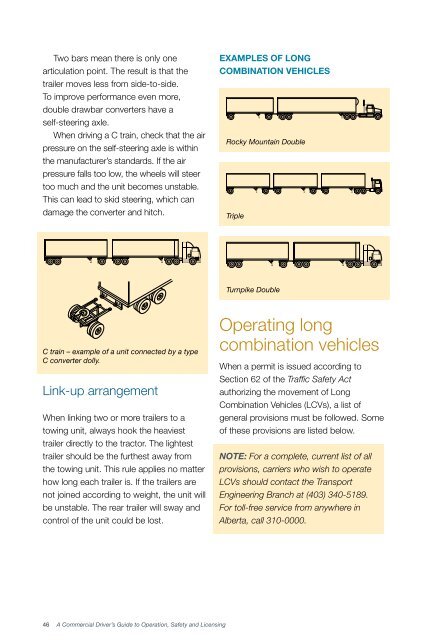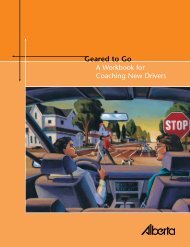Commercial driver's guide to operation, safety and licensing
Commercial driver's guide to operation, safety and licensing
Commercial driver's guide to operation, safety and licensing
You also want an ePaper? Increase the reach of your titles
YUMPU automatically turns print PDFs into web optimized ePapers that Google loves.
Two bars mean there is only one<br />
articulation point. The result is that the<br />
trailer moves less from side-<strong>to</strong>-side.<br />
To improve performance even more,<br />
double drawbar converters have a<br />
self-steering axle.<br />
When driving a C train, check that the air<br />
pressure on the self-steering axle is within<br />
the manufacturer’s st<strong>and</strong>ards. If the air<br />
pressure falls <strong>to</strong>o low, the wheels will steer<br />
<strong>to</strong>o much <strong>and</strong> the unit becomes unstable.<br />
This can lead <strong>to</strong> skid steering, which can<br />
damage the converter <strong>and</strong> hitch.<br />
Examples of long<br />
combination vehicles<br />
Rocky Mountain Double<br />
Triple<br />
Turnpike Double<br />
C train – example of a unit connected by a type<br />
C converter dolly.<br />
Link-up arrangement<br />
When linking two or more trailers <strong>to</strong> a<br />
<strong>to</strong>wing unit, always hook the heaviest<br />
trailer directly <strong>to</strong> the trac<strong>to</strong>r. The lightest<br />
trailer should be the furthest away from<br />
the <strong>to</strong>wing unit. This rule applies no matter<br />
how long each trailer is. If the trailers are<br />
not joined according <strong>to</strong> weight, the unit will<br />
be unstable. The rear trailer will sway <strong>and</strong><br />
control of the unit could be lost.<br />
Operating long<br />
combination vehicles<br />
When a permit is issued according <strong>to</strong><br />
Section 62 of the Traffic Safety Act<br />
authorizing the movement of Long<br />
Combination Vehicles (LCVs), a list of<br />
general provisions must be followed. Some<br />
of these provisions are listed below.<br />
Note: For a complete, current list of all<br />
provisions, carriers who wish <strong>to</strong> operate<br />
LCVs should contact the Transport<br />
Engineering Branch at (403) 340-5189.<br />
For <strong>to</strong>ll-free service from anywhere in<br />
Alberta, call 310-0000.<br />
46 A <strong>Commercial</strong> Driver’s Guide <strong>to</strong> Operation, Safety <strong>and</strong> Licensing




